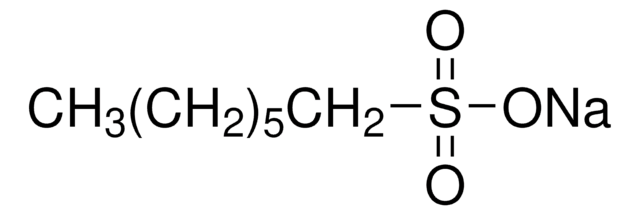About This Item
98 °C
83 mmHg ( 37.7 °C)
Recommended Products
grade
HPLC grade
vapor density
3.5 (vs air)
vapor pressure
40 mmHg ( 20 °C)
83 mmHg ( 37.7 °C)
Assay
≥96%
form
liquid
autoignition temp.
433 °F
composition
n-heptane, 96%
expl. lim.
7 %
greener alternative product characteristics
Safer Solvents and Auxiliaries
Learn more about the Principles of Green Chemistry.
sustainability
Greener Alternative Product
technique(s)
HPLC: suitable
impurities
<0.02% water
evapn. residue
<0.0003%
color
APHA: ≤10
refractive index
n20/D 1.387 (lit.)
bp
98 °C (lit.)
98 °C
mp
−91 °C (lit.)
solubility
acetone: miscible(lit.)
carbon tetrachloride: soluble(lit.)
ethanol: very soluble(lit.)
ethyl acetate: miscible(lit.)
water: insoluble(lit.)
density
0.684 g/mL at 25 °C (lit.)
λmax
400 nm (2nd)
λmax
0.01 at 254 nm
absorption
0.10 at 225 nm
0.40 at 210 nm
1.0 at 197 nm
application(s)
food and beverages
greener alternative category
, Aligned
SMILES string
CCCCCCC
InChI
1S/C7H16/c1-3-5-7-6-4-2/h3-7H2,1-2H3
InChI key
IMNFDUFMRHMDMM-UHFFFAOYSA-N
Looking for similar products? Visit Product Comparison Guide
General description
Tools and techniques for solvent selection: green solvent selection guides.
Heptane (n-Heptane) is a primary reference fuel (PRF) for the rating of octane numbers of fuels in internal combustion engines. Its cetane number has been reported to be 56. Mechanism and kinetic studies of its oxidation in flow reactors, shock tubes and rapid compression machines have been proposed. Its thermal decomposition has been studied under different conditions of temperature and pressure. Its oxidative dehydrogenation in the presence of magnesium oxide supported vanadium catalyst has been investigated. Molybdenum phosphide supported on Hβ zeolite (MoP/Hβ) catalyzed hydroisomerization of n-heptane has been reported to be enhanced by doping with secondary metals (Cr, Ni or Ce).
Application
- To compose the solvent mixtures for the purification of N-acylpyrrolidine derivatives of fatty acid methyl esters (FAMEs) by TLC (Thin Layer Chromatography).
- To generate chiral alcohols and heptanones, via whole cell double oxidation.
- As a solvent in the synthesis of isopropyl acetate, via esterification of acetic acid with isopropyl alcohol catalyzed by lipase immobilized on silica.
Features and Benefits
Packaging
As a global leader in lab reagents, we are constantly looking for new ways to optimize the safety of our products. The newly developed 4L solvent bottle design features advanced sealing technology that eliminates leaks to make the handling of solvents safer and more convenient than ever before.
See all the new features here!
Other Notes
Signal Word
Danger
Hazard Statements
Precautionary Statements
Hazard Classifications
Aquatic Acute 1 - Aquatic Chronic 1 - Asp. Tox. 1 - Flam. Liq. 2 - Skin Irrit. 2 - STOT SE 3
Target Organs
Central nervous system
Storage Class Code
3 - Flammable liquids
WGK
WGK 2
Flash Point(F)
24.8 °F - closed cup
Flash Point(C)
-4 °C - closed cup
Choose from one of the most recent versions:
Already Own This Product?
Find documentation for the products that you have recently purchased in the Document Library.
Customers Also Viewed
Our team of scientists has experience in all areas of research including Life Science, Material Science, Chemical Synthesis, Chromatography, Analytical and many others.
Contact Technical Service





